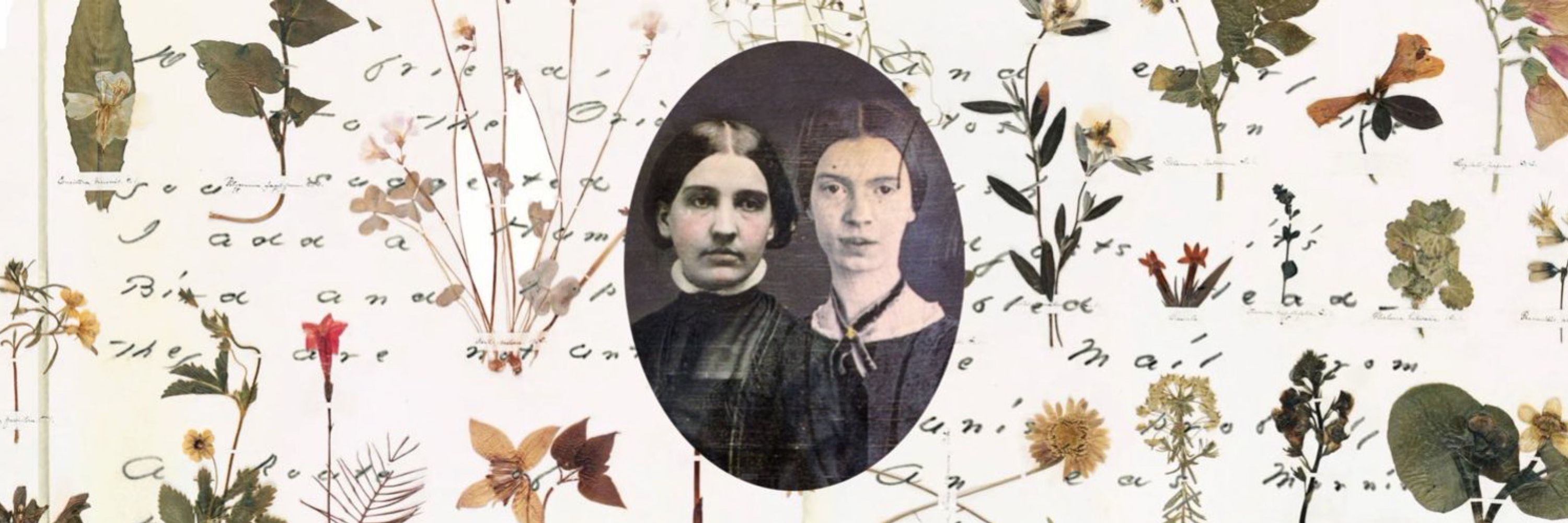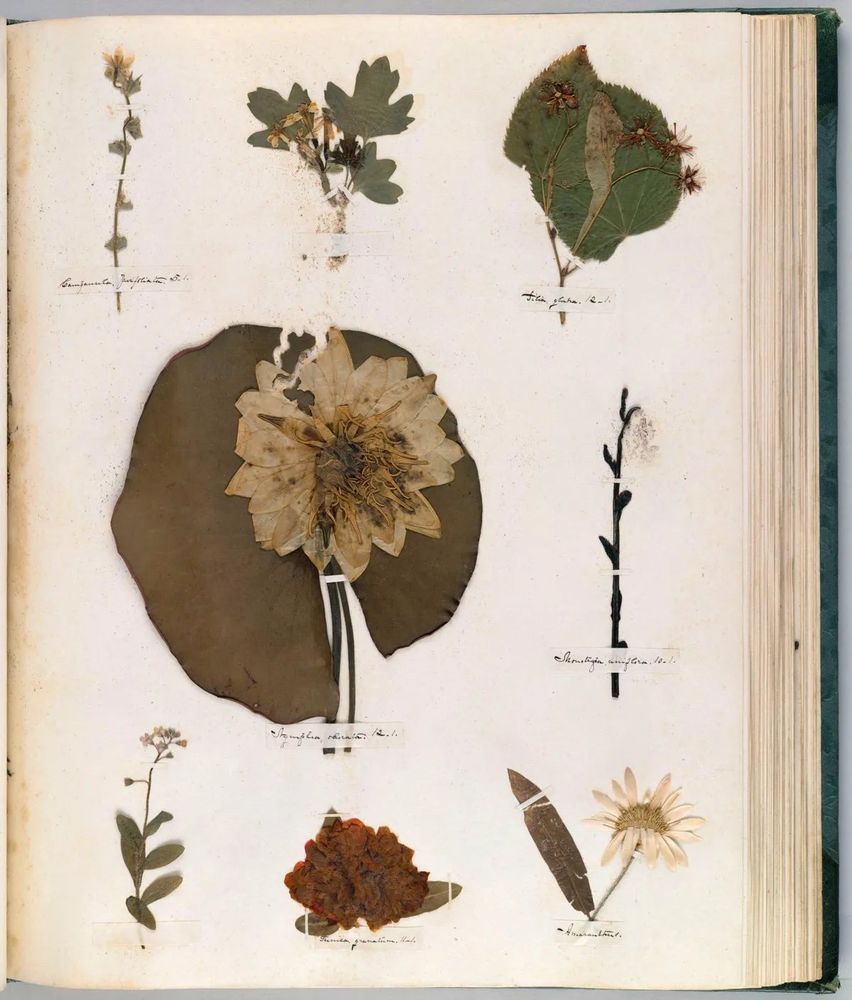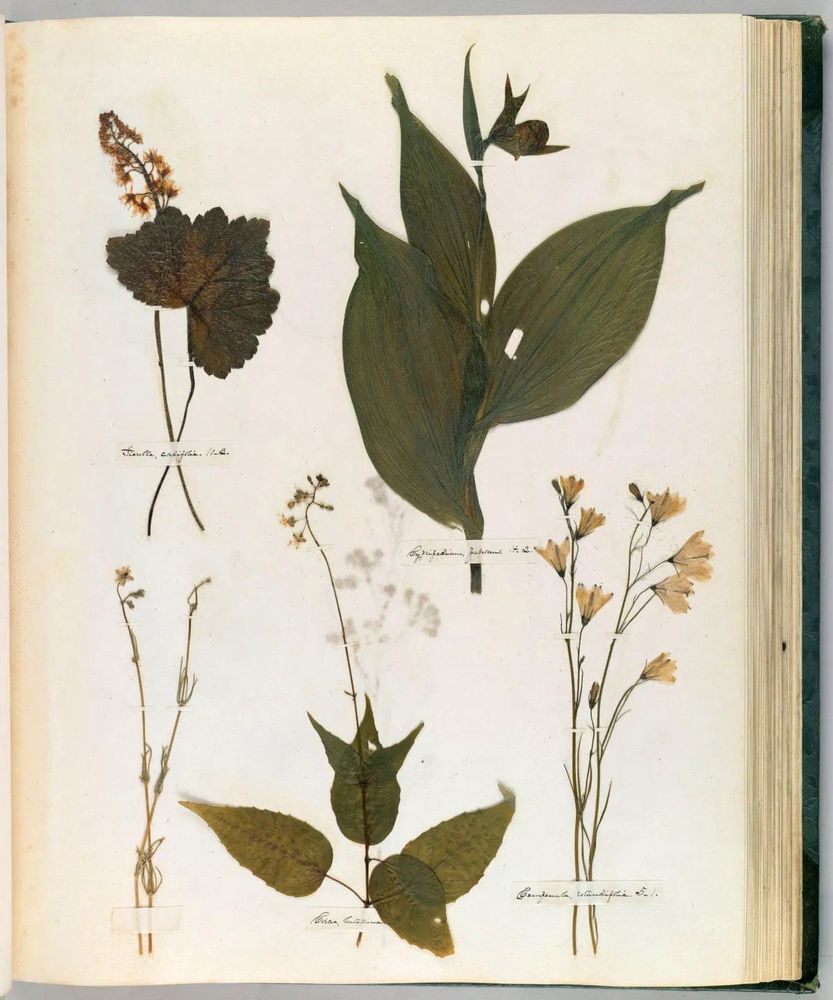
Emily Dickinson Bot
@emilydicknsonbot.bsky.social
Excerpts from Emily Dickinson's poems and letters.
Twitter: https://x.com/emilydicknsnbot
Instagram: instagram.com/emilydickinsonsgarden
Twitter: https://x.com/emilydicknsnbot
Instagram: instagram.com/emilydickinsonsgarden
Love is anterior to life,
Posterior to death,
Initial of creation, and
The exponent of breath.
Posterior to death,
Initial of creation, and
The exponent of breath.

September 4, 2024 at 10:18 PM
Love is anterior to life,
Posterior to death,
Initial of creation, and
The exponent of breath.
Posterior to death,
Initial of creation, and
The exponent of breath.
Only Woman in the World,
Accept a Julep
Sent to Susan Gilbert, mid 1870s
Accept a Julep
Sent to Susan Gilbert, mid 1870s

September 4, 2024 at 12:36 AM
Only Woman in the World,
Accept a Julep
Sent to Susan Gilbert, mid 1870s
Accept a Julep
Sent to Susan Gilbert, mid 1870s


September 1, 2024 at 6:58 PM
All sixty-six pages of Dickinson’s herbarium can be seen at the Harvard Libraries website: iiif.lib.harvard.edu/manifests/vi...


September 1, 2024 at 6:55 PM
All sixty-six pages of Dickinson’s herbarium can be seen at the Harvard Libraries website: iiif.lib.harvard.edu/manifests/vi...
Both her herbarium and her poetry can be situated within the 19th century “language of flowers,” a sentimental genre that Dickinson made her own, with her elliptical entwining of passion and secrecy.


September 1, 2024 at 6:54 PM
Both her herbarium and her poetry can be situated within the 19th century “language of flowers,” a sentimental genre that Dickinson made her own, with her elliptical entwining of passion and secrecy.
According to Judith Farr, author of The Gardens of Emily Dickinson, one-third of Dickinson’s poems and half of her letters mention flowers. She refers to plants almost 600 times, including 350 references to flowers.


September 1, 2024 at 6:53 PM
According to Judith Farr, author of The Gardens of Emily Dickinson, one-third of Dickinson’s poems and half of her letters mention flowers. She refers to plants almost 600 times, including 350 references to flowers.
One of the most aesthetically dramatic pages in the herbarium features eight different kinds of violet, a flower Dickinson cherished above others for the “unsuspected” splendor with which it ambushed the meadow-wanderer.


September 1, 2024 at 6:51 PM
One of the most aesthetically dramatic pages in the herbarium features eight different kinds of violet, a flower Dickinson cherished above others for the “unsuspected” splendor with which it ambushed the meadow-wanderer.
An especially peculiar feature of Dickinson’s herbarium is her choice for the opening page: tropical jasmine — not a plant native to the traditional flora of her time and place, but one native, perhaps, to the wilderness of her imagination —


September 1, 2024 at 6:50 PM
An especially peculiar feature of Dickinson’s herbarium is her choice for the opening page: tropical jasmine — not a plant native to the traditional flora of her time and place, but one native, perhaps, to the wilderness of her imagination —
What emerges is an elegy for time, composed with passionate patience, emanating the same wakefulness to sensuality and mortality that marks Dickinson’s poetry.


September 1, 2024 at 6:49 PM
What emerges is an elegy for time, composed with passionate patience, emanating the same wakefulness to sensuality and mortality that marks Dickinson’s poetry.
Slim paper labels punctuate the specimens like enormous dashes inscribed with the names of the plants — sometimes colloquial, sometimes Linnaean — in Dickinson’s elegant handwriting.


September 1, 2024 at 6:49 PM
Slim paper labels punctuate the specimens like enormous dashes inscribed with the names of the plants — sometimes colloquial, sometimes Linnaean — in Dickinson’s elegant handwriting.
Dickinson’s herbarium was a masterpiece of uncommon punctiliousness and poetic beauty: 424 flowers from the Amherst region, which Dickinson celebrated as “beautiful children of spring,” arranged with a remarkable sensitivity to scale and visual cadence across sixty-six pages.


September 1, 2024 at 6:48 PM
Dickinson’s herbarium was a masterpiece of uncommon punctiliousness and poetic beauty: 424 flowers from the Amherst region, which Dickinson celebrated as “beautiful children of spring,” arranged with a remarkable sensitivity to scale and visual cadence across sixty-six pages.
Mary Lyon, the school’s founder and first principal, was an ardent botanist herself, trained by the famous educator and horticulturalist Dr. Edward Hitchcock. Although Lyon encouraged all her girls to collect, study, and preserve local flowers in herbaria.


September 1, 2024 at 6:46 PM
Mary Lyon, the school’s founder and first principal, was an ardent botanist herself, trained by the famous educator and horticulturalist Dr. Edward Hitchcock. Although Lyon encouraged all her girls to collect, study, and preserve local flowers in herbaria.
Dickinson started studying botany at the age of nine and assisting her mother at the garden at twelve, but it wasn’t until she began attending Mount Holyoke in her late teens that she began approaching her botanical zeal with scientific rigor.


September 1, 2024 at 6:45 PM
Dickinson started studying botany at the age of nine and assisting her mother at the garden at twelve, but it wasn’t until she began attending Mount Holyoke in her late teens that she began approaching her botanical zeal with scientific rigor.
Long before she began writing poems, Dickinson undertook a rather different yet unexpectedly parallel art of contemplation and composition — the gathering, growing, classification, and pressing of flowers, which she saw as manifestations of the Muse not that dissimilar to poems.

September 1, 2024 at 6:44 PM
Long before she began writing poems, Dickinson undertook a rather different yet unexpectedly parallel art of contemplation and composition — the gathering, growing, classification, and pressing of flowers, which she saw as manifestations of the Muse not that dissimilar to poems.
Emily Dickinson’s herbarium; a thread.


September 1, 2024 at 6:44 PM
Emily Dickinson’s herbarium; a thread.
Emily Dickinson Bot from twitter is already here, guys! Help us to spread Emily Dickinson’s words and follow us on Instagram too. ✍️🤍


September 1, 2024 at 5:54 PM
Emily Dickinson Bot from twitter is already here, guys! Help us to spread Emily Dickinson’s words and follow us on Instagram too. ✍️🤍


